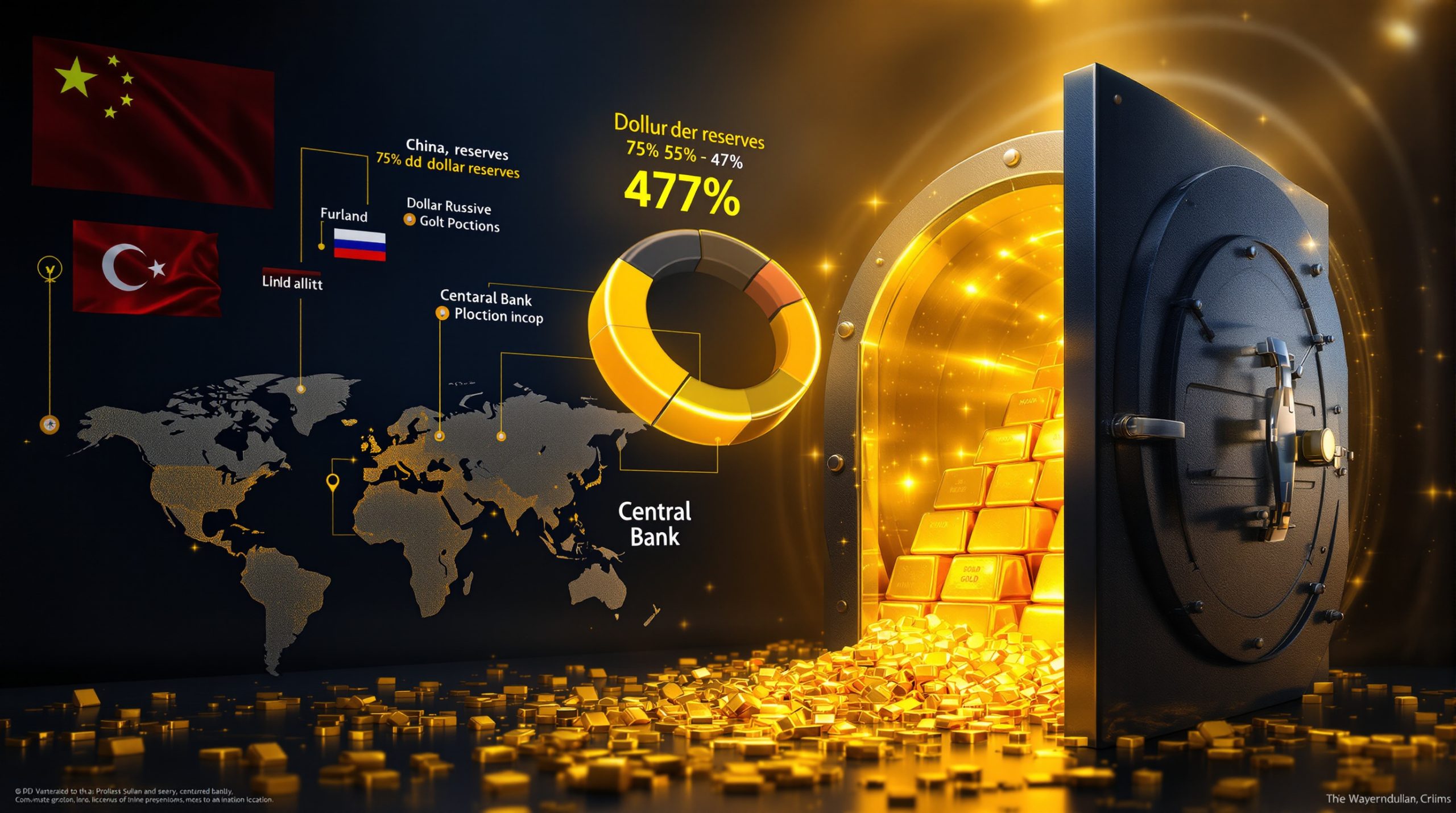What is the Relationship Between the US Dollar and Metal Markets?
The Inverse Correlation Explained
Most metals are priced in US dollars globally, creating a natural inverse relationship between the US dollar and metals decline. This relationship is foundational to understanding metal market dynamics.
When the dollar strengthens, metals become more expensive for buyers using other currencies, potentially reducing demand and putting downward pressure on prices. Conversely, a weaker dollar makes metals more affordable for international buyers, often boosting demand and supporting prices.
Historical data confirms this relationship: analysis shows that a 1% rise in the US Dollar Index historically correlates with a 0.3-0.7% decline in base metal prices (Federal Reserve Economic Data, 2024). This correlation is particularly strong for industrial metals like copper, which shows a -0.67 correlation coefficient with the dollar index.
"The dollar-commodity relationship is one of the most reliable patterns in financial markets, though its strength varies by metal type and can be temporarily overridden by supply shocks or geopolitical events." – World Gold Council, 2024
Currency effects can sometimes override fundamental supply-demand factors in short-term price movements, creating opportunities for traders who closely monitor copper price insights and other metal indicators.
Key Economic Mechanisms at Work
Several economic mechanisms drive the dollar-metal relationship:
Purchasing power dynamics:
- Weaker dollar increases buying power for metal importers using other currencies
- Metal consumption in non-dollar economies becomes more affordable
- Emerging markets with high metal intensity become more significant price drivers
Investment allocation shifts:
- Dollar weakness often drives institutional investors toward commodities as alternative stores of value
- Portfolio managers increase commodity allocations during inflationary periods
- Metal futures serve as dollar hedges in diversified portfolios
Central bank policies:
- Interest rate decisions directly impact both dollar strength and metal investment appeal
- Higher rates strengthen the dollar while raising opportunity costs for holding non-yielding metals
- Quantitative easing typically weakens the dollar while supporting metal prices
Global trade flows:
- Dollar fluctuations influence import-export balances in metal-producing regions
- Currency volatility affects mining company revenues and investment decisions
- Tariff policy impacts interact with currency effects on metal markets
This complex interplay means metal traders must monitor both macroeconomic data and currency markets to anticipate price movements effectively.
How Did Recent Dollar Movements Affect Metal Markets?
July 2025 Market Analysis
Recent market data provides a clear example of dollar-metal dynamics in action. According to Shanghai Metal Market (July 5, 2025), the US Dollar Index fell below the critical 97 mark, dropping 0.14% overnight and 0.29% on a weekly basis to close at 96.98.
Base metals responded with broad declines across both domestic and international exchanges:
| Metal | Overnight Change | Weekly Change |
|---|---|---|
| LME Copper | -1.03% | -0.85% |
| LME Nickel | -1.24% | -1.10% |
| Aluminum Futures | -0.79% | -0.66% |
| Casting Aluminum | -0.55% | -0.47% |
Ferrous metals followed a similar pattern with stainless steel falling 0.47%, while iron ore prices remained stable at ¥736/mt. Rebar and hot-rolled coil showed minimal movement with declines under 0.1%.
This data highlights the sometimes counterintuitive nature of metal markets – despite dollar weakness (which should theoretically support metal prices), most base metals declined, suggesting other factors were at play.
Precious Metals: The Exception to the Pattern
Precious metals demonstrated their unique position in the commodities space by diverging from the typical pattern:
- Gold futures rose 0.11% overnight despite dollar weakness, with a significant 1.79% weekly gain
- Silver showed similar strength with a 0.14% overnight increase and 2.1% weekly appreciation
- SHFE gold increased 0.19% with a weekly gain of 0.6%
- SHFE silver rose 0.16% over 24 hours and 1.24% weekly
This counter-trend movement highlights gold's dual role as both commodity and monetary asset. During periods of economic uncertainty, gold prices analysis shows that gold often attracts safe-haven demand regardless of dollar movements.
"Precious metals, particularly gold, benefit from a unique status as both industrial commodities and monetary assets. This dual nature means they can sometimes move independently of typical dollar correlations, especially during periods of heightened economic uncertainty." – CME Group, "Gold Futures Analysis," Q2 2025
This behaviour reflects gold's historical role as a store of value during times of currency volatility or geopolitical tension.
What Macroeconomic Factors Are Driving Current Metal Price Trends?
US Economic Indicators and Policy Shifts
Recent US economic data has significantly influenced metal markets through its impact on dollar valuation and interest rate expectations.
The Bureau of Labor Statistics reported that US non-farm payrolls increased by 147,000 in June, substantially exceeding the 110,000 forecast. Notably, government sector positions accounted for nearly half (48%) of this job growth, masking potential weakness in private sector hiring.
This labor market resilience has had important implications for the US economy outlook:
- Reduced expectations for immediate Federal Reserve rate cuts
- Strengthened dollar performance against major currencies
- Created headwinds for metal prices despite supportive fundamentals
The market still anticipates two rate cuts in 2025, with CME's FedWatch Tool showing a 93% probability of unchanged rates at the July Federal Open Market Committee meeting.
Another crucial factor is the Trump administration's planned tariff implementation. The July 8th deadline for reciprocal tariffs is creating significant market uncertainty, particularly for metals with global supply chains. These tariffs could potentially disrupt established trade flows and create price distortions in metal markets.
Chinese Economic Policy Developments
China, as both the world's largest metal consumer and a major producer, significantly influences global metal markets through its economic policies.
Recent developments include:
- People's Bank of China seeking comments on Cross-border Interbank Payment System (CIPS) rules, potentially easing international metal trade settlement
- SASAC director Zhang Yuzhuo emphasizing "strategic actions for mineral exploration and reserves expansion" – a policy stance that could boost metal demand
- Customs administration implementing measures to support free trade zones, potentially increasing metal import/export efficiency
- Upcoming economic data releases (CPI, PPI, M2 money supply) expected to provide further direction on Chinese metal demand
These policy shifts are particularly important given China accounts for approximately 50% of global demand for many base metals, including copper and aluminum.
"China's economic policy shifts often have outsized effects on metal markets due to the country's dominant position in both consumption and production. Even subtle regulatory changes can significantly impact global metal trade flows." – CRU Group, "Metals Market Outlook," 2025
Market participants are closely monitoring these developments for signals about future metal demand trends in the world's second-largest economy.
How Do Different Metal Categories Respond to Dollar Fluctuations?
Base Metals: High Sensitivity to Dollar Movements
Base metals typically show the highest sensitivity to dollar movements due to their global trade patterns and industrial applications.
Recent market data demonstrates this sensitivity:
- Copper showed the strongest reaction with a 1.03% decline following dollar weakness
- Nickel demonstrated even higher sensitivity with a 1.24% drop
- Aluminum displayed moderate correlation with a 0.79% decrease
This heightened dollar sensitivity stems from several factors:
Global trade dynamics:
- Base metals are primarily traded in dollars on international exchanges
- Industrial buyers are highly price-sensitive and quick to adjust purchasing patterns
- Mining companies factor currency expectations into production decisions
Manufacturing sector connections:
- Industrial metal demand closely tied to global manufacturing activity
- Exchange rates influence manufacturing competitiveness across regions
- Supply chains span multiple currency zones, amplifying currency effects
The correlation coefficient between the US Dollar Index and copper prices has historically ranged from -0.55 to -0.75, making it one of the most reliable inverse relationships in commodity markets.
Precious Metals: Complex Relationship with Currency
Precious metals exhibit a more complex relationship with the US dollar and metals decline, often moving counter to typical correlation patterns.
Recent market performance illustrates this complexity:
- Gold's 1.79% weekly gain despite dollar weakness demonstrates its safe-haven status
- Silver's 2.1% weekly increase reflects both industrial and investment demand
- Platinum and palladium showed mixed performance based on automotive sector outlook
Several factors drive this unique relationship:
Safe-haven dynamics:
- Precious metals often move counter to dollar trends during economic uncertainty
- Investors seek physical assets when concerned about currency debasement
- Gold's limited supply and historical monetary role support its value during crises
Central bank buying patterns:
- Official sector purchases significantly influence price movements
- Central banks diversify reserves away from dollars during certain economic cycles
- Emerging market central banks have increased gold allocations in recent years
The gold-dollar correlation can range from strongly negative (-0.8) during normal periods to near zero or even positive during acute financial stress, making it crucial for investors to understand the broader economic context.
Ferrous Metals: Moderate Dollar Influence
Ferrous metals typically show less sensitivity to dollar movements, as demonstrated by recent price stability.
Key observations from current market data:
- Iron ore prices remained stable at ¥736/mt despite dollar weakness
- Rebar and hot-rolled coil showed minimal price movement (<0.1% declines)
- Stainless steel demonstrated moderate sensitivity (-0.47%)
This reduced dollar influence stems from several structural factors:
Regional pricing mechanisms:
- Many ferrous metals are priced in local currencies rather than dollars
- Chinese yuan pricing for iron ore reduces direct dollar influence
- Regional supply-demand factors often override currency effects
Domestic policy decisions:
- Major steel-producing nations implement price support mechanisms
- Production quotas and capacity constraints buffer currency impacts
- Environmental regulations increasingly influence production costs
Vertical integration:
- Many steel producers control upstream raw materials
- Integrated operations reduce exposure to currency-driven price swings
- Long-term supply contracts often include currency adjustment mechanisms
These factors contribute to ferrous metals' reputation as more stable during currency volatility compared to their base metal counterparts.
What Should Investors Monitor in Metal Markets Going Forward?
Key Economic Data Releases
Successful metal market investors maintain vigilant monitoring of economic indicators that influence both metal demand and dollar valuation.
Priority data releases in the coming weeks include:
Chinese indicators:
- June foreign exchange reserves (indicating potential intervention)
- Consumer Price Index and Producer Price Index (inflation trends)
- M2 money supply (liquidity conditions affecting metal financing)
- Industrial production and fixed asset investment (direct metal demand signals)
US economic releases:
- Inflation expectations from University of Michigan survey
- Treasury bond auctions (indicating dollar demand)
- Weekly jobless claims (labor market strength)
- June inflation data (influencing Fed policy)
International indicators:
- European industrial output and retail sales figures
- Australian and Canadian employment statistics
- Japanese manufacturing PMI data
- Global trade balance reports
These indicators provide crucial context for understanding potential shifts in metal demand and dollar valuation.
Central Bank Policy Decisions
Central bank actions often create significant metal market volatility through their impact on currency values and economic growth.
Key upcoming central bank events include:
- US Federal Reserve meeting minutes release (July 10, 2025)
- Reserve Bank of Australia interest rate decision (July 8, 2025)
- Reserve Bank of New Zealand monetary policy assessment (July 17, 2025)
- Speeches from FOMC voting members on economic outlook
Investors should pay particular attention to language regarding:
- Inflation persistence and expectations
- Labor market conditions and wage pressures
- Economic growth forecasts and recession risks
- Balance sheet reduction plans (quantitative tightening)
Central bank divergence – when major central banks move in different directions – often creates the most significant opportunities in metal markets due to currency realignments.
Geopolitical Developments
Geopolitical factors increasingly influence metal markets through trade policy, sanctions, and supply disruptions.
Critical developments to monitor include:
- Implementation of US reciprocal tariffs after July 8th suspension period
- OPEC+ production decisions from weekend meeting
- Potential production increases from eight member countries
- Trade policy communications from US administration to trading partners
Metal market participants should also watch for oil price trends as they can impact:
- Mining regulation changes in major producing countries
- Environmental policy implementations affecting production
- Labor negotiations at major mining operations
- Transportation disruptions affecting metal shipments
Geopolitical risk premiums can temporarily override fundamental and currency factors, creating both risks and opportunities for informed investors.
How Do Energy Markets Interact with Metal Prices?
Crude Oil Price Movements
Energy costs represent a significant component of metal production expenses, creating important linkages between oil and metal markets.
Recent energy market developments include:
- US oil fell 0.75% overnight but gained 1.5% weekly
- Brent oil declined 0.42% overnight while posting 2.5% weekly increase
- OPEC+ weekend meeting signaled potential production increases
As Phil Flynn, senior analyst at Price Futures Group, noted: "There seems to be some profit-taking due to concerns that OPEC will increase production more than expected" (SMM, July 5, 2025).
Oil price movements matter for metal markets because energy represents 20-40% of production costs for many metals. This creates second-order effects that often lag the initial oil price changes.
Production Cost Implications
The energy-metal relationship varies significantly by metal type based on production processes and energy intensity.
Metal-specific energy impacts:
| Metal | Energy Cost % | Primary Energy Source | Price Sensitivity |
|---|---|---|---|
| Aluminum | 30-40% | Electricity | Very High |
| Copper | 20-25% | Diesel/Electricity | High |
| Steel | 15-20% | Coal/Natural Gas | Moderate |
| Gold | 10-15% | Diesel/Electricity | Low |
Aluminum smelting is particularly sensitive to energy price fluctuations due to the electrolytic reduction process, which consumes approximately 13,000-14,000 kWh per ton of aluminum produced.
Transportation costs for bulk commodities are also significantly affected by oil price trends. This is especially important for metals with low value-to-weight ratios like iron ore, where shipping can represent 15-20% of delivered cost.
Energy market developments create second-order effects on metal prices through:
- Direct production cost impacts
- Mine development decisions based on energy cost projections
- Modal shifts in metal transportation (rail vs. truck vs. ship)
- Energy efficiency investments in processing facilities
These relationships make energy price forecasts an essential component of metal market analysis.
What Are Expert Forecasts for Metal Markets?
Analyst Projections and Market Sentiment
Leading financial institutions and commodity specialists have issued updated forecasts for metal markets based on recent economic developments.
Notable projections include:
- Barclays raised its Brent crude forecast for 2025 by $6 to $72/barrel, citing improved demand outlook
- Commodity analysts broadly anticipate continued dollar weakness through Q3 2025, supporting metal prices
- Goldman Sachs expects copper to average $11,000/ton in H2 2025 due to electrification demand
- JPMorgan projects gold to reach $2,500/oz by Q4 on continued central bank buying
The consensus view suggests base metal price recovery if the dollar remains below the 97 mark on the DXY index. However, precious metals are expected to maintain strength regardless of dollar movements due to persistent economic uncertainty.
Supply-Demand Balance Expectations
Supply-demand fundamentals remain the long-term driver of metal prices, though they can be temporarily overshadowed by currency effects.
Key market balance projections:
- Copper market facing potential supply constraints from major producers in Chile and Peru
- Aluminum oversupply concerns moderating with production cuts in high-energy-cost regions
- Nickel market adjusting to increased Indonesian production capacity
- Precious metals benefiting from investment demand despite industrial usage fluctuations
For copper specifically, analysts project a market deficit of 250,000-300,000 tons in 2025, supporting prices despite macroeconomic headwinds. This deficit is driven by electrification trends in transportation and renewable energy infrastructure.
"We're entering a period where structural demand growth for certain metals, particularly copper, will increasingly override cyclical factors. The energy transition creates a long-term supportive environment regardless of short-term dollar movements." – CRU Group, "Copper Market Outlook," 2025
Investors should balance these longer-term fundamental trends against short-term currency and sentiment factors when developing metal market strategies.
FAQ: Common Questions About Dollar-Metal Relationships
Why do metals typically move inversely to the US dollar?
Metals typically move inversely to the US dollar and metals decline for several interconnected reasons:
-
Global pricing mechanism: Most metals are priced in US dollars on international exchanges, creating a mathematical relationship where a stronger dollar means fewer dollars are needed to buy the same amount of metal.
-
Purchasing power effects: When the dollar strengthens, buyers using other currencies
Wondering How to Spot the Next Major Mineral Discovery?
Discovery Alert's proprietary Discovery IQ model instantly notifies investors of significant ASX mineral discoveries, transforming complex data into actionable insights that give you a market-leading advantage. Visit our discoveries page to understand why major mineral discoveries can lead to exceptional returns and begin your 30-day free trial today.




